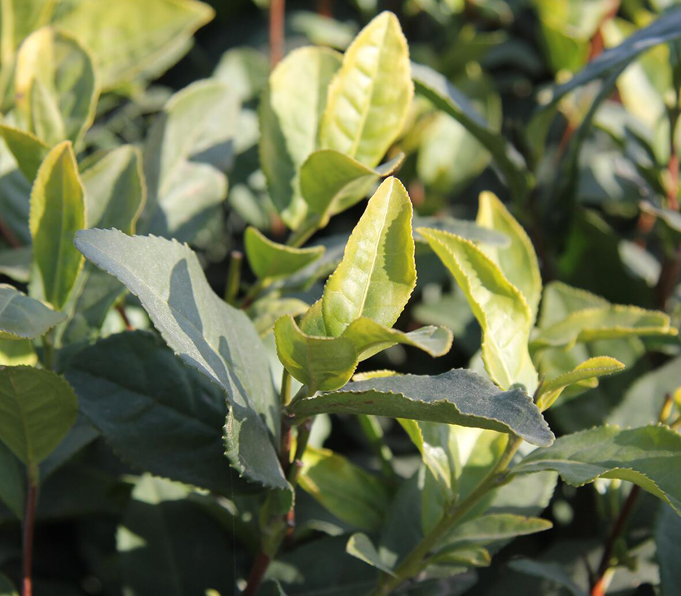

外源物质对茶树耐寒及蔗糖代谢关键基因表达的影响
收稿日期: 2019-02-13
录用日期: 2019-05-07
网络出版日期: 2019-05-09
Effect of Exogenous Substances on Cold Tolerance and Key Sucrose Metabolic Gene Expression in Camellia sinensis
Received date: 2019-02-13
Accepted date: 2019-05-07
Online published: 2019-05-09
冬春季节低温伤害是影响茶树(Camellia sinensis)生产的重要因素。以茶树盆栽苗为试验材料, 通过喷施不同浓度的γ-氨基丁酸(GABA)、绿藻粉和竹醋液溶液, 研究低温胁迫下3种外源物质对茶树耐寒能力的影响, 并对蔗糖代谢关键基因SPS、SUS4、INV4和INV5表达量及耐寒相关生理指标进行分析, 解析外源物质影响茶树耐寒性的生理与分子机制。结果表明, 低温胁迫下, 用不同浓度GABA、绿藻粉和竹醋液喷施处理茶树盆栽苗叶片, 其冻害指数和相对电导率显著低于对照; 可溶性糖含量显著高于对照, 以10 mmol·L -1GABA、0.22 mg·mL -1绿藻粉及2.5 mg·mL -1竹醋液处理效果最佳。低温胁迫下, 与清水处理相比, 分别用10 mmol·L -1GABA、0.22 mg·mL -1绿藻粉或2.5 mg·mL -1竹醋液处理茶树盆栽苗后, 茶树苗丙二醛含量显著降低, 抗氧化酶活性显著提高; 叶片叶绿素、可溶性糖和脯氨酸含量显著增加, 蔗糖含量在处理72小时后分别增加了15.24%、11.39%和5.97%; SPS、SUS4、INV4和INV5基因的表达量显著升高。实验结果表明, GABA、绿藻粉和竹醋液能显著增强茶树的耐寒性。研究结果可为茶树抗寒剂的筛选提供理论依据。

杨小青,黄晓琴,韩晓阳,刘腾飞,岳晓伟,伊冉 . 外源物质对茶树耐寒及蔗糖代谢关键基因表达的影响[J]. 植物学报, 2020 , 55(1) : 21 -30 . DOI: 10.11983/CBB19024
In recent years, low temperature damage in winter and spring has become an important factor affecting tea production. We used tea tree (Camellia sinensis) potted seedlings to test the effect of GABA, chlorella powder and bamboo vinegar on sucrose-related gene expression (SPS, SUS4, INV4, INV5) and cold-tolerant related physiological indexes. Different concentrations of the three kinds of exogenous substances were sprayed on seedlings under cold stress. We analyzed the expression of SPS, SUS4, INV4 and INV5 of the key sucrose-coding genes as well as the physiological indexes related to cold tolerance to determine the possible physiological and molecular mechanisms of the effect of exogenous substance spraying on cold tolerance of tea trees. The frost index and relative conductivity were significantly lower after application of GABA, chlorella powder or bamboo vinegar than control values and the soluble sugar content was increased. The optimal application concentration for GABA, chlorella powder and bamboo vinegar was 10 mmol·L -1, 0.22 mg·mL -1 and 2.5 mg·mL -1, respectively. Malondialdehyde content was significantly decreased and antioxidant enzyme activity was increased; chlorophyll, soluble sugar and proline content was also increased. Sucrose content was increased by 15.24%, 11.39% and 5.97%, respectively, after 72 h treatment. The expression of SPS, SUS4, INV4 and INV5 in leaves was significantly increased with 10 mmol·L -1 GABA, 0.22 mg·mL -1 chlorella powder and 2.5 mg·mL -1 bamboo vinegar. Thus, GABA, chlorophyll powder and bamboo vinegar can significantly improve the cold tolerance of tea plants. We provide a theoretical basis for the cryoprotectant selection for tea plants.

Key words: tea tree; low temperature stress; soluble sugar; sucrose; cryoprotectant
| [1] | 艾沙江·买买提, 张校立, 梅闯, 闫鹏, 王继勋 (2016). 保水剂、绿藻粉处理对库尔勒香梨抗冻能力的影响. 新疆农业科学 53, 445-454. |
| [2] | 陈贵, 胡文玉, 谢甫绨, 张立军 (1991). 提取植物体内MDA的溶剂及MDA作为衰老指标的探讨. 植物生理学通讯 27, 44-46. |
| [3] | 陈杭芳 (2007). NaHSO3提高春茶产量、品质和抗冻性机制探讨. 硕士论文. 杭州: 浙江大学. pp. 27-35. |
| [4] | 丁菲 (2012). 低温胁迫下与茶树糖代谢相关基因的克隆与表达. 硕士论文. 合肥: 安徽农业大学. pp. 1-8. |
| [5] | 葛菁 (2012). HPLC-ELSD测定茶树可溶性糖含量及GS基因的克隆与表达. 硕士论文. 合肥: 安徽农业大学. pp. 3-5. |
| [6] | 黄娟 (2015). 外源GABA对温度胁迫下黄瓜生长的影响. 硕士论文. 重庆: 西南大学. pp. 25-42. |
| [7] | 黄伟峰, 商晗武, 高永生, 胡剑光, 余秋珠, 王道泽 (2012). 竹醋基液抗寒剂对茶树抗寒性的影响. 茶叶科学 32, 432-440. |
| [8] | 李合生 (1999). 植物生理生化实验原理和技术. 北京: 高等教育出版社. pp. 164-165. |
| [9] | 林郑和, 钟秋生, 游小妹, 陈志辉, 陈常颂, 单睿阳, 阮其春 (2018). 低温胁迫对茶树抗氧化酶活性的影响. 茶叶科学 38, 363-371. |
| [10] | 刘慧英, 朱祝军 (2002). 转化酶在高等植物蔗糖代谢中的作用研究进展. 植物学报 19, 666-674. |
| [11] | 刘凌霄, 沈法富, 卢合全, 韩庆点, 刘云国 (2005). 蔗糖代谢中蔗糖磷酸合成酶(SPS)的研究进展. 分子植物育种 3, 275-281. |
| [12] | 孙鲁龙, 耿庆伟, 邢浩, 杜远鹏, 翟衡 (2017). 低温处理葡萄根系对叶片PSII活性的影响. 植物学报 52, 159-166. |
| [13] | 孙世利, 骆耀平, 潘顺顺, 凌彩金, 苗爱清, 赵超艺 (2008). 壳聚糖对茶树抗寒性相关指标的影响研究. 广东农业科学 ( 12), 34-37. |
| [14] | 田景花, 王红霞, 张志华, 高仪 (2015). 低温逆境对不同核桃品种抗氧化系统及超微结构的影响. 应用生态学报 26, 1320-1326. |
| [15] | 王连荣, 刘铁铮 (2010). 果树抗寒生理与防寒措施的研究进展. 安徽农业科学 38, 9483-9484. |
| [16] | 王平盛, 虞富莲 (2002). 中国野生大茶树的地理分布、多样性及其利用价值. 茶业科学 22, 105-108, 134. |
| [17] | 王素平, 郭世荣, 胡晓辉, 李璟, 焦彦生 (2006). 盐胁迫对黄瓜幼苗叶片光合色素含量的影响. 江西农业大学学报 28, 32-38. |
| [18] | 王育平 (2014). 茶树冻害成因及预防补救措施. 福建农业科技 ( 5), 47-49. |
| [19] | 熊先军, 刘明月 (2005). 辣椒抗寒性生理生化研究进展. 辣椒杂志 1, 9-12. |
| [20] | 许英, 陈建华, 朱爱国, 栾明宝, 王晓飞, 孙志民 (2015). 低温胁迫下植物响应机理的研究进展. 中国麻业科学 37, 40-49. |
| [21] | 岳川 (2015). 茶树糖类相关基因的挖掘及其在茶树冷驯化中的表达研究. 博士论文. 北京: 中国农业科学院. pp. 52-75. |
| [22] | 张贱根 (2006). 茶树冻害的发生与预防补救措施. 茶业通报 28(1), 12-13. |
| [23] | 张丽, 周欣, 蒋家月, 江昌俊, 朱政 (2012). 外源ABA对茶树抗寒生理指标的影响. 茶业通报 34, 72-74. |
| [24] | 周琳, 陈暄, 王玉花, 朱旭君, 黎星辉, 房婉萍 (2014). 超敏蛋白对低温胁迫下茶树生理特性的影响. 园艺学报 41, 746-754. |
| [25] | Baud S, Vaultier MN, Rochat C (2004). Structure and expression profile of the sucrose synthase multigene family in Arabidopsis. J Exp Bot 55, 397-409. |
| [26] | Benina M, Obata T, Mehterov N, Ivanov I, Petrov V, Toneva V, Fernie AR, Gechev TS (2013). Comparative metabolic profiling of Haberlea rhodopensis, Thellungiella halophyla, and Arabidopsis thaliana exposed to low temperature. Front Plant Sci 4, 499. |
| [27] | Dhindsa RS, Matowe W (1981). Drought tolerance in two mosses: correlated with enzymatic defence against lipid peroxidation. J Exp Bot 32, 79-91. |
| [28] | Dong HZ, Sun LH, Jian LC (1980). Ultrastructural changes in leaf cells of wheat varieties with different cold resistance after freezing-thawing of the plants. Acta Bot Sin 22, 339-342. |
| [29] | Otting G, Liepinsh E, Wuthrich K (1991). Protein hydration in aqueous solution. Science 254, 974-980. |
| [30] | Ruan YL (2014). Sucrose metabolism: gateway to diverse carbon use and sugar signaling. Ann Rev Plant Biol 65, 33-67. |
/
| 〈 |
|
〉 |